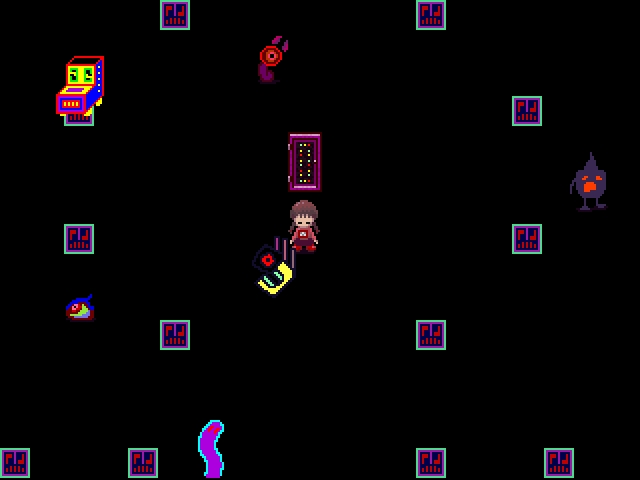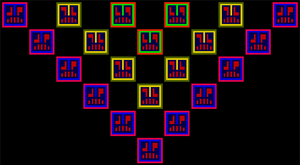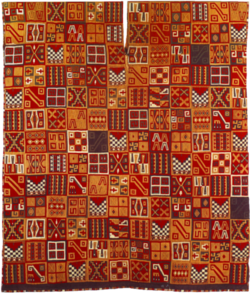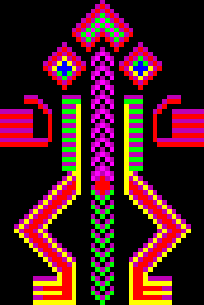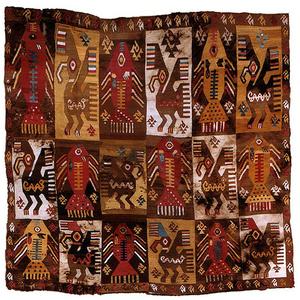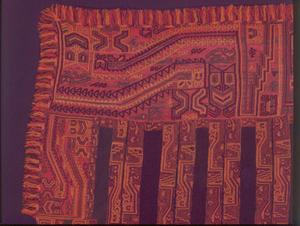>Mt.kiki No edit summary |
mNo edit summary |
||
| (6 intermediate revisions by 5 users not shown) | |||
| Line 33: | Line 33: | ||
==[[Neon World]]([http://en.wikipedia.org/wiki/Hopi_mythology Hopi mythology])== | ==[[Yume Nikki:Neon World|Neon World]]([http://en.wikipedia.org/wiki/Hopi_mythology Hopi mythology])== | ||
[http://en.wikipedia.org/wiki/Hopi_mythology#Major_deities <u>1 Major deities</u>] | [http://en.wikipedia.org/wiki/Hopi_mythology#Major_deities <u>1 Major deities</u>] | ||
| Line 60: | Line 60: | ||
== | ==Neon World([http://en.wikipedia.org/wiki/Wiphala Wiphala])== | ||
The '''Wiphala''' (Quechua pronunciation: [http://en.wikipedia.org/wiki/Help:IPA [wɪˈpʰɐlɐ]]) is a square emblem, commonly used as a [http://en.wikipedia.org/wiki/Flag flag], representing the [http://en.wikipedia.org/wiki/Indigenous_peoples_of_the_Americas native peoples] of all the [http://en.wikipedia.org/wiki/Andes Andes] that include today's Bolivia, Peru, Ecuador and parts of Argentina, Chile and Colombia. It exists in several modern varieties, which represent the [http://en.wikipedia.org/wiki/Inca_Empire Inca Empire] (''Tawantin Suyu'') and each of its former four regions (''suyus''). | The '''Wiphala''' (Quechua pronunciation: [http://en.wikipedia.org/wiki/Help:IPA [wɪˈpʰɐlɐ]]) is a square emblem, commonly used as a [http://en.wikipedia.org/wiki/Flag flag], representing the [http://en.wikipedia.org/wiki/Indigenous_peoples_of_the_Americas native peoples] of all the [http://en.wikipedia.org/wiki/Andes Andes] that include today's Bolivia, Peru, Ecuador and parts of Argentina, Chile and Colombia. It exists in several modern varieties, which represent the [http://en.wikipedia.org/wiki/Inca_Empire Inca Empire] (''Tawantin Suyu'') and each of its former four regions (''suyus''). | ||
[[File:600px-Banner_of_the_Qulla_Suyu_svg.png|thumb|150px|right|Neon World(Wiphala)]] | [[File:600px-Banner_of_the_Qulla_Suyu_svg.png|thumb|150px|right|Neon World(Wiphala)]] | ||
The ''Cusco'' Wiphala consists of seven horizontal stripes representing the [http://en.wikipedia.org/wiki/Colour colours] of the [http://en.wikipedia.org/wiki/Rainbow rainbow]. | The ''Cusco'' Wiphala consists of seven horizontal stripes representing the [http://en.wikipedia.org/wiki/Colour colours] of the [http://en.wikipedia.org/wiki/Rainbow rainbow]. | ||
※the [http://en.wikipedia.org/wiki/Colour colours] of the [http://en.wikipedia.org/wiki/Rainbow rainbow].⇒[http://yumenikki.wikia.com/wiki/Neon_World Neon World]([http://en.wikipedia.org/wiki/Wiphala Wiphala]) | ※the [http://en.wikipedia.org/wiki/Colour colours] of the [http://en.wikipedia.org/wiki/Rainbow rainbow].⇒[http://yumenikki.wikia.com/wiki/Neon_World Neon World]([http://en.wikipedia.org/wiki/Wiphala Wiphala]) | ||
==[[Yume Nikki:Neon Creatures|Neon Creatures]]([http://en.wikipedia.org/wiki/Andean_textiles Andean textiles])== | |||
==[[ | |||
Andean textiles represent a continuing textile tradition spanning at least ten thousand years. Fiberwork has been found in [http://en.wikipedia.org/wiki/Guitarrero_Cave <u>Guitarrero Cave</u>], Peru dates back to 8000 BCE.<sup class="reference" id="cite_ref-1">[http://en.wikipedia.org/wiki/Andean_textiles#cite_note-1 <u>[1</u>]]</sup> | Andean textiles represent a continuing textile tradition spanning at least ten thousand years. Fiberwork has been found in [http://en.wikipedia.org/wiki/Guitarrero_Cave <u>Guitarrero Cave</u>], Peru dates back to 8000 BCE.<sup class="reference" id="cite_ref-1">[http://en.wikipedia.org/wiki/Andean_textiles#cite_note-1 <u>[1</u>]]</sup> | ||
| Line 100: | Line 101: | ||
== | ==Neon Creatures([http://en.wikipedia.org/wiki/Andean_textiles Andean textiles])== | ||
| Line 132: | Line 133: | ||
== | ==Neon Creatures([http://en.wikipedia.org/wiki/Andean_textiles Andean textiles])== | ||
[[File:Paracas Mantle.jpg|thumb|left|300px|Chimu Mantle]] | [[File:Paracas Mantle.jpg|thumb|left|300px|Chimu Mantle]] | ||
| Line 183: | Line 184: | ||
<p class="fileinfo"> | <p class="fileinfo"> | ||
</p> | </p> | ||
[[Category: | [[Category:Yume Nikki theoretical discussions by Mt.kiki]] | ||
Latest revision as of 04:13, 24 April 2023
Neon World(Hopi mythology)
Most Hopi accounts of creation center around Tawa, the Sun Spirit. Tawa is the Creator, and it was he who formed the First World out of Tokpella, or Endless Space, as well as its original inhabitants.[6]
Red,Purple,Yellow,Green color(Tawa-Kachina color)
Neon World(Wiphala)
The Wiphala (Quechua pronunciation: [wɪˈpʰɐlɐ]) is a square emblem, commonly used as a flag, representing the native peoples of all the Andes that include today's Bolivia, Peru, Ecuador and parts of Argentina, Chile and Colombia. It exists in several modern varieties, which represent the Inca Empire (Tawantin Suyu) and each of its former four regions (suyus).
The Cusco Wiphala consists of seven horizontal stripes representing the colours of the rainbow.
※the colours of the rainbow.⇒Neon World(Wiphala)
Neon Creatures(Andean textiles)
Andean textiles represent a continuing textile tradition spanning at least ten thousand years. Fiberwork has been found in Guitarrero Cave, Peru dates back to 8000 BCE.[1]
"Tupa Inca tunic", c. 1550, Dumbarton Oaks
Neon Creatures(Andean textiles)
Chimu slit tapestry, 1000–1476 CE, pelicans and tuna fish design in camelid fiber
Neon Creatures(Andean textiles)
Paracas mantle 200 CE Larco Museum, Lima-Perú
Anonymous
02/23/13 (Sat) 22:48:33No.[[|1365]]
File: 1361688513148.png (487.56 KB, 640x480, Untitled-1.png)
http://uboachan.net/t/res/973.html#1365

